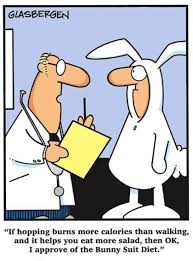by therapyinsdcom | Apr 27, 2017 | Cognitive Behavioral Therapy, Uncategorized, weight loss
It’s sunblock and swimsuit time in San Diego! Most of us are making sure we have our summer essentials in place, and pretty soon it will be time do your favorite summer activities! Like clockwork, my clients begin to express anxiety about an upcoming pool party or BBQ where they may be wearing a lot less than they have in the last few months. I’m getting the annual calls asking, “Can I use CBT for weight loss?”, and more often, “I can lose the weight but gain it right back, how can you help me?”.
If you’ve never lost a pound or if you’ve successfully lost weight only to gain it back, you are certainly not alone. Cutting calories, exercising more, and watching your carbs is not enough on their own. Almost everyone knows what they need to do to lose weight, but may not be clear on how to make it happen. The most powerful aspect of moving towards a healthy body is a change in mindset. Knowing that each individual has their own reasons for wanting to change, what works for one client will almost certainly not work for everyone. Creating a specific plan, tailored to your unique thought process, can make a significant difference in effective weight loss.
What is the best diet plan for weight loss?
 You can use any reasonable diet you want- when you pair it with new habits of thought you will see it work. The question is not simply ‘What is the best weight loss plan?’, but rather- ‘How can I think differently about myself and my health?’. This is where cognitive behavioral therapy (CBT) comes into play, as it guides you to focus on changing your perceptions of yourself and replace sabotaging thoughts, which can lead to massive long-term changes in your health.
You can use any reasonable diet you want- when you pair it with new habits of thought you will see it work. The question is not simply ‘What is the best weight loss plan?’, but rather- ‘How can I think differently about myself and my health?’. This is where cognitive behavioral therapy (CBT) comes into play, as it guides you to focus on changing your perceptions of yourself and replace sabotaging thoughts, which can lead to massive long-term changes in your health.
Do this first before anything else….
One of the first exercises I complete with clients is to create an ‘advantages’ card, which is outlined with more detail in Judith Beck’s book outlining CBT for weight loss, The Beck Diet Solution. When you write down the reasons you want to lose weight, it can really add a boost to your motivation. Looking at it a couple of times a day can build excitement in reaching your big goal. The advantages card is your ‘eyes on the prize’ reminder, and whenever you hear yourself saying “One donut won’t hurt”, you pull out your handy card out to kindly remind you what you truly want. The more you conquer your cravings, the more confident you will become in knowing you can do this!
Messed up? Excellent!
Relapse is part and parcel of changing any habit- it’s also one of the most exciting opportunities for change. Now is when your new CBT for weight loss skills are put to the test, as you begin to see how to shift your behaviors and habits that combat those negative, self-sabotaging thoughts. We only change when we are uncomfortable, so when you are struggling or simply doubting yourself this is when the magic happens. Most of us are much more capable than we give ourselves credit for; imagine how pushing yourself through this challenge will confirm strong you really are. This is the time to use your supports to boost you up and let you know you can do it!
If you’re reading this, it’s likely that you’ve already discovered that establishing weight loss plans on without outside help often doesn’t produce the results you aim for. Evaluating and making shifts in the way you look at your problem can create a long-lasting solution that will not only help you lose weight, but also help you recognize skills and resources within you that can be useful in any aspect of your life.
Like this article about CBT for weight loss? Here is a similar blog from the archive:
Cognitive Behavioral Therapy for Weight Loss
by therapyinsdcom | Mar 27, 2017 | Anxiety, Cognitive Behavioral Therapy, Depression

Positive psychologists and cognitive behavioral therapists promote certain behaviors that prime the brain for happiness.
Shawn Achor is one of my personal heroes- you may have heard of him as the author of ‘The Happiness Advantage’ or through his infamous TED Talk which you can find here. After almost a half a century in the making, positive psychology is sweeping the mental health landscape and I couldn’t be more thrilled. Cognitive behavioral therapists, educators and behavioral scientists are adopting techniques, such as the ‘happiness advantage’ to help people shift their mindset towards the good.
A Cognitive Therapist’s Answer to “Why Can’t I Find Happiness?”
‘Happiness’ makes many think of smiles, the sunshine, material acquisitions, and absolute bliss. People often perceive ‘happy’ as being beyond our control, that it has to do with external factors or some level of intangible success. However, when you depend on external factors to reach this mysterious state, you set yourself up for fleeting joy but also long-term disappointment, which can lead to depression and anxiety.
Contentment does not have to be controlled by external factors, what you have achieved, or what you or someone else consider the ultimate success. Rather than telling yourself that happiness is something to wait for, or believing that a partner, weight loss, or more money will lead you there, you can train your brain to be positive in the here and now. According to Shawn, if your brain is focused on positivity, it performs 31% more productively than when it is negative, neutral, or stressed. With the happiness advantage, your intelligence, creativity, and energy levels rise. That said, it makes much more sense to focus on how happiness leads to success, instead of the other way around.
It makes sense that managing depression and anxiety can be approached in a different and more effective way- by creating a new internal reality. As you learn how to become more positive in the present, the solution may not seem as hard to achieve. Training your brain to be more positive is something you’ve already taught it to do other tasks until it becomes automatic. Have you ever catch your fingers hitting the ‘F’ for Facebook without even noticing? Reaching for the snooze button? These are both common examples of automatic thoughts.
Let’s Get Happy!
Over time, reversing your formula for happiness in the now and leading your brain to focus on the present and the positive aspects is a mighty force. The trick is to act differently right now, and your brain will begin to become primed for success, which means that you will be able to work harder, faster, and more intelligently in the moment as well as long-term. One of the ways that your brain can be trained is to encourage the release of dopamine, which is a vital ‘feel good’ hormone. Dopamine has two functions: first, to make you happier and second, to trigger all of your learning centers in your brain- of course, you’ve already watched Shawn Achor’s TED Talk and know this, right?
When I work with clients who are looking for solutions to anxiety or depression, I make sure I focus on behaviors instead of feelings. There are several actions that can train your brain to produce more of that precious dopamine. Shawn asserts that if you practice a positive habit daily for 21 days in a row, you can build a habit and train your brain to be more positive. Three ways to achieve this are to:
- Journaling- Write down one positive experience in the past 24-hours, so that your brain can relive that experience and start focusing on it. This habit teaches your brain that what you do and what actions you take each day matter.
- Meditation- Take the time to slow down and meditate, giving your brain a chance to stop multitasking and to focus more on one task, such as the matter at hand. Opportunites to meditate are everywhere and are easier that you may think, as this article by Temma Ehrenfeld discusses.
- Random act of kindness- Completing a conscious act of kindness can increase the dopamine levels in your brain, such as writing a positive email to a friend, praising a friend for something they accomplished, thanking someone for their support, or simply complimenting someone on their clothes or hair. Personally, this is one of my favorites. A few years ago I published an article on how volunteering can battle a sour mood. Do you live in my town of San Diego? Volunteer Match is a super way to get on it!
As the exercises above reflect, CBT helps you learn skills needed to be happier and more content. Behavioral interventions can be simple and if practiced every day, these types of activities help improve depressed moods and how to be happier in the present!
Happiness is within your control and is attainable with daily practice. Building some simple habits into your daily life will help you create that positivity and happiness that you desire. If you’ve already been influenced by Shawn Achor’s work, please comment below- I’d love to hear from you!
by therapyinsdcom | Jan 16, 2017 | Anxiety, Cognitive Behavioral Therapy
Ambiguity, a sense of uncertainty about what’s going on or what might happen, is part of life. We all need to be able to tolerate ambiguity, yet this isn’t always easy. This post explores dealing with the unknowns in life and how to handle it.
What in the World is Going on Right Now?
All around the globe, people are waiting to see what will happen after the seismic shift in the U.S. Presidential election. Many of my clients have spoken about a myriad of emotions,  ranging from elation to grief, but all agree it’s uncomfortable to not know what might happen.
ranging from elation to grief, but all agree it’s uncomfortable to not know what might happen.
Our discomfort for not knowing is well grounded in experimental psychology. Research has shown that when given the choice, most people would prefer to receive an electrical shock immediately rather than wait and possibly be shocked later.
Daniel Gilbert, author of the best-selling book Stumbling on Happiness writes:
“Consider an experiment by researchers at Maastricht University in the Netherlands who gave subjects a series of 20 electric shocks. Some subjects knew they would receive an intense shock on every trial. Others knew they would receive 17 mild shocks and 3 intense shocks, but they didn’t know which of the 20 trials the intense shocks would come. The results showed that subjects who thought there was a small chance of receiving an intense shock were more afraid — they sweated more profusely, their hearts beat faster than subjects who knew for sure that they’d receive an intense shock”.
Two Ways to Handle Anxiety:
We can’t hope to eliminate ambiguity in our lives but we can manage our reactions to ambiguity in healthy ways using one of two techniques that the best cognitive behavioral therapists employ:
– The “Worst Case Scenario”
This CBT technique helps clients analyze their fears and address them in a logical way. Not knowing what will happen often leads to an unhealthy level of negative thinking and anxiety. People can be too quick to imagine horrible outcomes. The ‘Worst Case Scenario Technique’ is a seven-step process that individuals can use to confront and manage their fears about the outcome of an event, big or small. The technique can be summarized this way:
1. Picture one of your worries
2. Identify worries associated with that event.
3. List the worries that come from that worry.
4. Use if/then thinking to deal with each worry.
5. Acknowledge your ability to cope with the outcome.
6. Work out how you would handle a “worst case scenario” if it happens.
7. Choose a final image or phrase to use against your worries.
– The A.C.C.E.P.T.S Technique
If you find that your rumination is unproductive or gets in the way of doing things you enjoy, temporary distractions can be immensely useful. When there is no way to control an outcome and you find yourself emotionally flooded, it’s time to shift course to a more productive way of doing things. Consciously choosing to focus on something for a time gives your mind some rest and relief. The acronym A.C.C.E.P.T.S stands for distraction techniques individuals can use to feel better fast:
1. Activities – Do some housework or go for a walk.
2. Contributing – Do a little volunteer work
3. Comparisons – Compare your new self to your old self, or yourself to others.
4. Emotions – Do something to evoke the opposite of a negative emotion.
5. Pushing Away – Consciously push the distressing thoughts away.
6. Thoughts – Think about anything else that you can concentrate on.
7. Sensations – Do something positive to engage your senses.
Learn to use one or two of those strategies whenever ongoing ambiguity becomes a real burden. While practicing under the guidance of a therapist can be useful, the techniques themselves are easy to understand.
Quiz: How Well Do You Manage Uncertainty?
Everyone has a different level of tolerance for ambiguity. Wondering how good you are at tolerating ambiguity? There is an easy way to find out. The Tolerance for Ambiguity scale will tell you. You will respond to a set of 16 statements about your attitudes and behaviors. Whether your score is particularly high, or lower than you expected, it is interesting to know where you stand. This information might also be helpful to a therapist who you consult to help you manage anxiety.
Life is full of suspense….. Public reactions to the 2016 presidential election make it clear that uncertainty about the future can throw the best of us. We all face personal circumstances that create unhelpful worry and stress. If so, using distraction techniques or working out the worst case scenario and how you can respond constructively can be key cognitive behavioral therapy interventions that you can use to help you feel more grounded and engaged with the real world.
by therapyinsdcom | Aug 26, 2015 | Anxiety, Cognitive Behavioral Therapy
Can Cognitive Behavioral Therapy (CBT) Treat Anxiety?
Anxiety is a feeling of worry, restlessness or uneasiness that typically occurs when we are faced with an imminent situation or one that we have little control over. While it is normal, and even helpful, to experience some level of anxiety from time to time, problems occur when anxiety is out of control, causes phobias or makes it difficult for you to live a productive and healthy life, hold a job or maintain important relationships.
Anxiety causes emotional strain on the individual, and it can also manifest physically in a variety of ways including causing shortness of breath, an irregular heartbeat, gastric and intestinal distress, insomnia, sweating, trembling and dizziness. In some cases, these physical conditions can only be controlled with medication, but in most cases, they can be effectively treated by managing your anxiety by enlisting a cognitive therapist.

When a cognitive behavioral therapist addresses anxiety we approach the problem from many different angles and target three areas in particular:
- Our emotions
- Our behaviors
- Our thoughts
In addition to addressing the biological and environmental components of one’s life, Cognitive behavioral therapy (CBT) is an effective intervention that addresses all three of these areas. It helps individuals to become aware of their negative thought patterns and self-doubt, learn how to behave proactively when faced with anxiety-inducing situations and feel empowered to utilize their most effective coping strategies as well as develop new ones.
Cognitive Components that Impact Anxiety
Cognitive behavioral therapy provides clients with opportunities to openly examine their own thoughts and uncover beliefs that may be unhelpful. Examples of this include realizing that you think you will fail at a job interview before it begins (catastrophization) or believing that a car crash is imminent anytime you get behind the wheel (fortune telling). This discovery process provides opportunities for change which through confronting one’s faulty logic. Cognitive recognition also provides clients with a clearer understanding of how beliefs influence their mental and physical state when certain situations present themselves. It can also alter ‘self-talk’ and replace it with kinder, more loving and forgiving dialogue that decreases anxiety and increases opportunities for success.
Behaviors and Anxiety
Cognitive behavioral therapy examines how individuals act when faced with a specific situation. The goal is to identify and shift maladaptive habits that people with social anxiety or other anxiety disorders tend to repeat and sabotage potential. Clients are then provided with behavioral experiments to change behavioral patterns and adopt effective coping mechanisms to use in a variety of anxiety-inducing situations.
Changing Emotions
Cognitive behavioral therapy offers opportunities for clients to consider how their thoughts and actions make them feel. By changing how you think about an anxiety-provoking situation and how you act when faced with it, you can change the way that you feel about that situation and sometimes, turn it into a situation that you can turn down the volume of your anxious feelings. This can be a powerful discovery and one that teaches clients how to actively participate in choosing how they will react and what their path will be.
Reach Goals Sooner with Cognitive Behavioral Therapy
With cognitive behavioral therapy, clients often see results in as little as a few sessions. This is a major advantage because it has the potential to increase their confidence level and cause them to believe that they can overcome unhealthy anxiety. With their newfound hopefulness, many move forward in a more positive direction and achieve a sense of calm when faced with situations that previously triggered intense anxiety.
Trust and a Strong Client / Therapist Relationship
For cognitive behavioral therapy to be the most effective, it is important that the client is comfortable with the psychotherapist. This is especially true for clients who are prone to extreme anxiety when situations leave them feeling uncomfortable. The highest level of comfort often develops naturally when the therapist treats the client as an equal and an integral part of the healing process. Effective therapists include clients in developing their treatment plan and ask for feedback after every therapy session. Therapists must also realize that each client is an individual, and no one treatment plan will work for every person. This type of attitude fosters mutual respect and cooperation between the therapist and the client. It also increases feelings of hopefulness and curiosity about the potential for therapy that can reduce the number of sessions it takes to reach the client’s goals of reducing or eliminating anxiety and increase opportunities for success.
Anxiety disorders can take over your life and have a crippling effect on your ability to realize happiness but are also one of the most treatable conditions in the mental health spectrum. You can take positive steps to change how you react to stressful situations. As a licensed psychotherapist in San Diego, cognitive behavioral therapy is one solution that I most often recommend to help clients with anxiety walk the path toward happier, more productive lives. If the time is right to realize positive change in your life, contact me to schedule a consultation.
by therapyinsdcom | Sep 15, 2014 | Cognitive Behavioral Therapy, Depression
Think about the last encounter you had with a friend or co-worker where you discussed sleep. You probably said something like, “You wouldn’t believe how tired I am! I only slept for five hours last night.” Your friendly likely responded with, “That’s nothing! I only got three hours of sleep.”
Examining this interaction, one would be led to believe that getting just a couple hours of sleep is worthy of a badge of honor. On the other hand, I’ll tell you something quite different.
What are the consequences of sleep deprivation?
 When I have a client come into my office, one of the first questions I ask them is “How much sleep are you getting?” Have you ever thought about your sleep habits might affect your mental health? Sleep deprivation is clearly linked to increased anxiety, depression, and even psychosis in patients. In my experience clients who are suffering from any mental disorders will typically see symptoms improve remarkably with adequate shut eye.
When I have a client come into my office, one of the first questions I ask them is “How much sleep are you getting?” Have you ever thought about your sleep habits might affect your mental health? Sleep deprivation is clearly linked to increased anxiety, depression, and even psychosis in patients. In my experience clients who are suffering from any mental disorders will typically see symptoms improve remarkably with adequate shut eye.
Arguably the most dangerous consequence of sleep deprivation is a slower response time. The adage that a tired driver is more dangerous than a drunk driver is has been established over and over again in studies; cognitive effects of sleep deprivation may lead to mistakes, errors in judgment, and even psychosis. This relates to memory storage and even the decision-making process. If you haven’t been getting enough sleep, you are probably missing details at work or working on projects for school.
How much sleep do I need?
Truth be told, there really isn’t a specific amount of sleep that each person should aim for. Some people operate just fine with six hours, but some people need more than eight. Generally, you should always wake up feeling refreshed just a few minutes before the alarm rings.

What can I do to avoid sleep deprivation?
Sometimes going to bed earlier seems like an impossible feat, especially when issues like stress, temperature and diet come into play. You can create a bedtime ritual that gets your mind ready for sleep. Shut off the television and keep the electronics out of the bedroom for better sleep, and consider practicing good sleep hygiene.
Sleep deprivation is often related to psychological disorders. If this is the case, a therapist may be able to help. Cognitive behavioral therapy is a useful tool a professional might use to help you change your sleeping habits.
by therapyinsdcom | Sep 1, 2014 | Anxiety, Cognitive Behavioral Therapy, Depression
 In today’s society, adults face many challenges in their daily lives. With demanding schedules, the struggle to maintain a work-life balance and increasing mental health concerns, a greater number of adults are reaching out for therapeutic assistance to help them cope with their day to day lives and break down their barriers to happiness. With the help of a qualified mental health professional, many are able to work through the problems they are facing, recognize their coping techniques and use their established resources and strengths to live healthier, happier lives.
In today’s society, adults face many challenges in their daily lives. With demanding schedules, the struggle to maintain a work-life balance and increasing mental health concerns, a greater number of adults are reaching out for therapeutic assistance to help them cope with their day to day lives and break down their barriers to happiness. With the help of a qualified mental health professional, many are able to work through the problems they are facing, recognize their coping techniques and use their established resources and strengths to live healthier, happier lives.
Adult Therapy – A Journey Toward a Healthier, Happier Life
While some individuals shy away from therapy because they associate it with weakness or feelings of inferiority, seeking the assistance of a qualified mental health professional is actually a testament of strength and displays a willingness to take responsibility for life’s most difficult events and seek out positive change. An adult therapist provides a high level of support and insight into challenging situations and assists clients in honing in on existing strengths in order to overcome obstacles to happiness.
Cognitive Behavioral Therapy Explained
When it comes to adult therapy, one method that has shown particular effectiveness in various clinical studies is Cognitive Behavioral Therapy. Cognitive Behavioral Therapy, or CBT as it is often referred to, is a collaborative effort between a therapist and her client that incorporates empathy, warmth and genuineness. The initial goal of CBT is to develop a clear understanding of the problems or barriers at hand and devise a path toward remedying those barriers and breaking down maladaptive patterns. Cognitive Behavioral Therapy is goal oriented, directive and time limited, meaning the individual seeking therapy is assisted in understanding the specific purpose of their sessions in order to direct their attention toward resolving or adjusting negative thought patterns with a clear end in sight. For many, CBT sessions are more effective than other forms of therapy, such as psychoanalysis, in a much shorter period of time. Several clinical studies have shown that adults participating in CBT often see significant improvement in 16 sessions or less. The end result of successful CBT is positive life changes that incorporate the adult’s strengths and lead to a happier, more fulfilling lifestyle.
Cognitive Behavioral Therapy for Adults – Past and Current Uses
Cognitive Behavioral Therapy was initially used for adults facing depression and anxiety. While this style of therapy is still a top choice for therapists assisting clients with these concerns today, it has also proven effective in treating other conditions including eating disorders, substance abuse problems, sleep disorders, post traumatic stress disorder, or PTSD, and attention deficit hyperactivity disorder, or ADHD, in adults. Basically, CBT works by helping a client to identify a problematic way of thinking. In the case of ADHD, this might mean that a client realizes he believes he is stupid because of poor grades and progress in his educational career. In the case of an anxiety disorder, this might mean the person comes to the realization that she always believes she is in danger. Once this line of thinking is established, the therapist works with the client to challenge thought patterns and paint a more realistic picture of why life experiences are the way they are. Next, the client is taught to recognize strengths and reshape feelings, thoughts and associated actions. This leads to the individual learning how to adapt thinking patterns and develop more productive behaviors and a healthier self image.
CBT is an effective adult therapeutic tool for individuals of all ages and in all walks of life, but it is important to seek the assistance of an experienced, trained therapist to gain the greatest results in the shortest amount of time. A qualified therapist will conduct an initial consultation and understand any barriers the individual is facing before therapy begins. The therapist will then tailor future sessions to assist the client in overcoming any barriers and empower the client to feel comfortable and successful in the therapeutic relationship.
Approaches to CBT for Adults
Cognitive Behavioral Therapy for adults is sometimes a stand-alone treatment, and it is sometimes combined with medications for those who require them. Consulting with a qualified mental health professional is the best way to decide how this course of treatment should be used in your particular situation and what, if any, additional medications or therapeutic practices you might also benefit from.
As a professional psychotherapist in San Diego, I have witnessed the many benefits that Cognitive Behavioral Therapy offers adults. I believe in empowering clients to recognize their own barriers to happiness and overcome them with the strengths that exist inside them, and that is a primary reason why CBT is one of many therapeutic approaches I use in my daily practice. If you are seeking a San Diego adult therapist to assist with any of the obstacles that life has thrown your way, contact my office today to schedule a free, no obligation CBT consultation. Together, we can work toward improving your outlook on life and moving toward your happier tomorrow.
 You can use any reasonable diet you want- when you pair it with new habits of thought you will see it work. The question is not simply ‘What is the best weight loss plan?’, but rather- ‘How can I think differently about myself and my health?’. This is where cognitive behavioral therapy (CBT) comes into play, as it guides you to focus on changing your perceptions of yourself and replace sabotaging thoughts, which can lead to massive long-term changes in your health.
You can use any reasonable diet you want- when you pair it with new habits of thought you will see it work. The question is not simply ‘What is the best weight loss plan?’, but rather- ‘How can I think differently about myself and my health?’. This is where cognitive behavioral therapy (CBT) comes into play, as it guides you to focus on changing your perceptions of yourself and replace sabotaging thoughts, which can lead to massive long-term changes in your health. 
 ranging from elation to grief, but all agree it’s uncomfortable to not know what might happen.
ranging from elation to grief, but all agree it’s uncomfortable to not know what might happen.
 When I have a client come into my office, one of the first questions I ask them is “How much sleep are you getting?” Have you ever thought about your sleep habits might affect your mental health? Sleep deprivation is clearly linked to increased anxiety, depression, and even psychosis in patients. In my experience clients who are suffering from any mental disorders will typically see symptoms improve remarkably with adequate shut eye.
When I have a client come into my office, one of the first questions I ask them is “How much sleep are you getting?” Have you ever thought about your sleep habits might affect your mental health? Sleep deprivation is clearly linked to increased anxiety, depression, and even psychosis in patients. In my experience clients who are suffering from any mental disorders will typically see symptoms improve remarkably with adequate shut eye.
 In today’s society, adults face many challenges in their daily lives. With demanding schedules, the struggle to maintain a work-life balance and increasing mental health concerns, a greater number of adults are reaching out for therapeutic assistance to help them cope with their day to day lives and break down their barriers to happiness.
In today’s society, adults face many challenges in their daily lives. With demanding schedules, the struggle to maintain a work-life balance and increasing mental health concerns, a greater number of adults are reaching out for therapeutic assistance to help them cope with their day to day lives and break down their barriers to happiness.